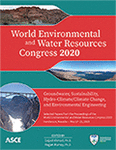World Environmental and Water Resources Congress 2020
Optimal In Situ Bioremediation System Design for Contaminated Groundwater Using Meshless EFGM Simulation and PSO
Publication: World Environmental and Water Resources Congress 2020: Groundwater, Sustainability, Hydro-Climate/Climate Change, and Environmental Engineering
ABSTRACT
In situ bioremediation is the widely accepted technology for the remediation of groundwater sites contaminated with organic contaminants. However, designing an optimal in situ bioremediation system for the contaminated sites is a major challenge to the groundwater scientists. In the past, the various simulation-optimization (S/O) models have been proposed for the optimization of in situ bioremediation system. An S/O model couples the groundwater flow, contaminant, and oxygen transports simulations with an optimization algorithm. The well locations and their pumping rates are the important entities in determining the optimal in situ bioremediation cost. However, the simulation models utilized in the previous in situ bioremediation studies were mostly based on the finite difference method (FDM) and finite element method (FEM), and hence, they are only capable of locating the optimal well locations from the discretized nodes in the computational domain. In this study, we propose an S/O model where the simulator called BIOEFGM is based on the meshless element-free Galerkin method (EFGM) and it is integrated with the particle swarm optimization (PSO). BIOEFGM uses the moving least squares (MLS) approximation for computing the shape functions and hence, it provides stability in approximating the unknown variables in governing equations. In the developed S/O model, meshless BIOEFGM allows PSO to test all the locations i.e., coordinates of the discretized nodes as well of the remaining portion for the optimality. In this study, BIOEFGM-PSO model is used for the optimal in situ bioremediation of the two-dimensional aquifer site. BIOEFGM model is first verified with FEM and then used with the PSO. The selected problem is also solved with FEM-PSO model for comparing the bioremediation costs. The optimal bioremediation cost from the BIOEFGM-PSO is found to be less than that from the FEM-PSO. This study shows the advantages of using the proposed model and therefore, can be applied to the large field problems.
Get full access to this article
View all available purchase options and get full access to this chapter.
REFERENCES
Belytschko, T., Lu, Y. Y., and Gu, L. (1994). “Element-free Galerkin methods.” International Journal for Numerical Methods in Engineering, 37(2).
Borden, R. C., and Bedient, P. B. (1986). “Transport of dissolved hydrocarbons influenced by oxygenlimited biodegradation: 1. Theoretical development.” Water Resources Research, 22(13), 1973–1982.
Kumar, R. P., and Dodagoudar, G. R. (2010). “Meshfree analysis of two-dimensional contaminant transport through unsaturated porous media using EFGM.” Journal of Numerical Methods in Biomedical Engineering, 26(12), 1797–1816
Liu, G. R., and Gu, Y. T. (2005). An Introduction to Meshfree Methods and Their Programming. Springer, Dordrecht.
Meenal, M., and Eldho, T. I. (2011). “Simulation of groundwater flow in unconfined aquifer using meshfree point collocation method.” Engineering Analysis with Boundary Elements, 35(4), 700-707.
Meenal, M., and Eldho, T. I. (2012). “Two-dimensional contaminant transport modeling using meshfree point collocation method (PCM).” Engineering Analysis with Boundary Elements, 36(4), 551–561.
Pathania, T., Bottacin-Busolin, A., Rastogi, A. K., and Eldho, T. I. (2019). “Simulation of Groundwater Flow in an Unconfined Sloping Aquifer Using the Element-Free Galerkin Method.” Water Resources Management, 33, 2827–2845.
Prasad, R.K., and Mathur, S. (2006). “In situ bioremediation of contaminated groundwaterusing artificial neural network.” World Environmental and Water ResourceCongress 2006.
Rifai, H. S., Bedient, P. B., Borden, R. C., and Haasbeek, J. F. (1987). BIOPLUME II: Computer Model of Two-Dimensional Contaminant Transport Under the Influence of Oxygen Limited Biodegradation in Ground Water, User’s Manual Version 1.0. National Center for Ground Water Research, Rice University, Houston, Texas.
Rifai, H. S., Newell, C. J., Gonzales, J. R., Dendrou, S., Kennedy, L., and Wilson, J.T. (1997). BIOPLUME III Natural Attenuation Decision Support System, User’s, Manual, Version 1.0. Air Force Center for Environmental Excellence (AFCEE), San Antonio.
Shieh, H.-J., and Peralta, R. C. (2005). “Optimal in situ bioremediation design by hybrid genetic algorithm-simulated annealing.” Journal of Water Resources Planning and Management, 131(1), 67-78.
Sudheer, C., Kumar, D., Prasad, R. K., and Mathur, S. (2013). “Optimal design of an in situ bioremediation system using support vector machine and particle swarm optimization.” Journal of Contaminant Hydrology, 151, 105-116.
Swathi, B., and Eldho, T. I. (2014). “Groundwater flow simulation in unconfined aquifers using meshless local Petrov-Galerkin method.” Engineering Analysis with Boundary Elements, 48, 43-52.
Taylor, S. (1993). “Modeling enhanced in situ biodegradation in groundwater: Model response to biological parameter uncertainty”. Proceedings: Groundwater Modeling Conference 1993.
Yadav, B., Ch, S., Mathur, S., and Adamowski, J. (2016). “Estimation of in situ bioremediation system cost using a hybrid Extreme Learning Machine (ELM)-particle swarm optimization approach.” Journal of Hydrology, 543, 373-385.
Yoon, J.-H., and Shoemaker, C. A. (1999). “Comparison of Optimization Methods for Ground-Water Bioremediation.” Journal of Water Resources Planning and Management, 125(1), 54-63.
Information & Authors
Information
Published In
World Environmental and Water Resources Congress 2020: Groundwater, Sustainability, Hydro-Climate/Climate Change, and Environmental Engineering
Pages: 115 - 124
Editors: Sajjad Ahmad, Ph.D., and Regan Murray, Ph.D.
ISBN (Online): 978-0-7844-8296-4
Copyright
© 2020 American Society of Civil Engineers.
History
Published online: May 14, 2020
Published in print: May 14, 2020
Authors
Metrics & Citations
Metrics
Citations
Download citation
If you have the appropriate software installed, you can download article citation data to the citation manager of your choice. Simply select your manager software from the list below and click Download.
